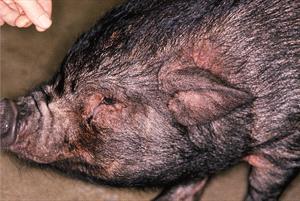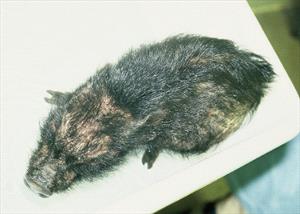Erythematous skin in an adult pig with sarcoptic mange.

An adult pig with sarcoptic mange. Photo courtesy of Dr. Lisle George.
Sarcoptic mange is a parasitic skin disease that is highly contagious and common among pet pigs. It is particularly prevalent in new pet pigs who formerly lived with other pigs.
What Causes Sarcoptic Mange?
A mite called Sarcoptes scabiei var. suis causes it in pigs. These mites dig into and feed on the pig’s skin, causing irritation, itching and a range of other symptoms. The mites mate and lay eggs in the pig’s skin, allowing them to grow rapidly and continue causing signs.
Sarcoptic mange may be transmitted among pigs through direct skin-to-skin contact, or contact with contaminated surfaces such as bedding.
Signs
Signs of sarcoptic mange include:
- Itching
- Flaking skin
- Thickened and crusty skin (mainly on front legs, ears and torso)
- Scrapes and scabs on skin
- Red lumps on skin
- Hair loss
- Depression
- Weight loss
- Lethargy
- Mild fever
Juvenile pig with sarcoptic mange.

Juvenile pig with sarcoptic mange. Photo courtesy of Dr. Lisle George
Generally, it takes about 2-3 weeks for many of these symptoms to emerge at full strength.
Diagnosis
Your veterinarian will rely on the pig’s signs, information from you, a physical examination, and identification of the mange mites. To identify these mites, they will scrape off a bit of the pig’s skin with a blade and look at the skin under the microscope. If mange mites or eggs are seen, the pig has sarcoptic mange.
Treatment
Sarcoptic mange is often treated with 2 to 3 injections of an anti-parasitic drug, such as ivermectin. To prevent reinfection, after each injection you should change the pig’s bedding, vacuum carpets the pig was using, and wash and spray with insecticides anything the pig touched. If you have more than one pig, isolate the affected pig to prevent the others from getting it. Ask your veterinarian which insecticide will work best in your case.
Can Pigs Give Mange to People?
Sarcoptic mites can potentially spread from pet pigs to humans. Therefore, for your own safety, it is a good idea to wear gloves and a medical-type gown, or clothes you only wear when with the pig, when interacting with your affected pig. It can cause severe skin disease in human infants, so keep infected pigs away from babies. If you notice itchiness and red bumps on your skin, contact your physician.